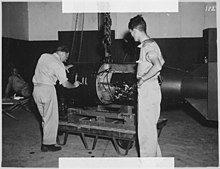Little boy
Little Boy ( English for Little Boy ) was the code name of the first set in a war bomb that on August 6, 1945 by the B-29 bomber Enola Gay of the USAAF over the Japanese city of Hiroshima was dropped, hence the name Hiroshima bomb . The nuclear weapon with a charge of uranium had been developed from the beginning of 1942 in the course of the Manhattan Project and achieved an explosive force of around 13 kilotons of TNT .
In the nuclear weapon explosion and the firestorm initiated by it, 20,000 to 90,000 people died immediately; Many of the survivors (" Hibakusha ") suffer to this day from the long-term effects of the radioactive exposure . Three days later, the second Fat Man atomic bomb was dropped on Nagasaki . This used plutonium as fissile material and was much stronger with 21 kilotons of TNT equivalent .
Ignition mechanism
Little Boy was built according to the simple but very reliable “ cannon principle ”. A failure of the construction was considered very unlikely, so that a test was not carried out. The first nuclear weapon explosion carried out, the Trinity test carried out on July 16, 1945 , was used to review the design of the much more complex Fat Man bomb, which was constructed as an " implosion bomb " and used plutonium for nuclear fission .
With the cannon principle, two subcritical uranium masses are combined into one critical mass by an explosion of conventional explosives, which leads to a chain reaction . Although this construction is safer than the implosion principle, it required the entire world supply of U-235 at that time and could therefore not be duplicated. Plutonium was already present in sufficient quantities during the Trinity test in New Mexico, but no one knew whether the charge would actually ignite. That's why Little Boy was used first.
The bomb was only fitted with the detonator and cordite charges by weapons officer Captain William "Deak" Parsons during the flight to Hiroshima and only armed shortly before the target area. The ignition mechanism was three-stage: the first stage consisted of a clockwork that started immediately after being dropped and activated the second stage after 15 seconds. This included a barometric altitude measurement and was intended to prevent the two radar altimeters (code name "Archie"), as the actual detonators, from triggering the explosion prematurely. The type of radar antenna used was developed by the Japanese Yagi Hidetsugu in the 1930s. The two “Archie” radar altimeters were not armed until about 2000 m above sea level, which then triggered the chain reaction at the optimal altitude of 580 m. Triggering controlled solely by air pressure (barometrically) would have been too imprecise to detonate the bomb at the predetermined altitude.
Little Boy contained a total of 64 kg uranium with a proportion of 80% 235 U. At least part of the uranium came from the approximately 1,100 tons of uranium ore and uranium oxide that the US Army captured in Stassfurt in the second half of April 1945 . According to current estimates, less than a kilogram of the total mass was split by the nuclear reaction.
commitment
On August 6, 1945 at 8:15:17 a.m. local time, the Enola Gay bombardier released the bomb at a height of 9,450 meters. The B-29 under the command of Colonel Paul Tibbets then flew a turning maneuver in order not to be caught by the pressure wave.
At the predicted height of 580 meters, the bomb exploded with around 13 kilotons of TNT equivalent explosive force, killing 20,000 to 90,000 people immediately and destroying 80 percent of the city. Many people were badly irradiated and died shortly afterwards. To this day, the victims known as " Hibakusha " in Japan suffer from the effects of radiation exposure .
Little Boy was the first of two nuclear weapons to be detonated in a military conflict to date .
Data

| Weight | 4040 kg (8900 lbs ) |
| length | 3.20 m (10.5 ft ) |
| diameter | 0.71 m (28 in ) |
| Fissile material | 64 kg (38.4 kg target mass and 25.6 kg projectile mass) uranium |
| Neutron reflector | Tungsten carbide |
| Neutron source | Polonium - beryllium |
| Propellant | dibasic nitrocellulose - gunpowder ( cordite ) |
| ignition | electrically by radar altimeter |
| Explosive force | 12–18 kT (13.4 kT calculated in advance) |
| Explosion height | 600 ± 15 m (1900 ± 50 ft) |
Web links
- Nuclear chain reactions and the cannon principle Simulation of "Little Boy" with Unity on beltoforion.de
Individual evidence
- ^ Richard Rhodes: Dark Sun: The making of the Hydrogen Bomb. Touchstone 1996, pp. 160, 161.


